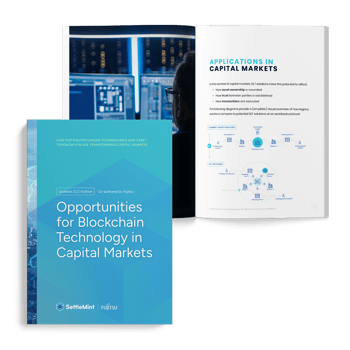Banking and financial services
Utilizing distributed ledger technologies in banking and finance provides not only improved operations efficiency and reduced risk versus legacy systems, it also presents huge potential for new products and services.
Opportunities for Blockchain Technology in Capital Markets

Blockchain enables true digitalization
The digitalization and automation of banking and financial services promises to improve efficiencies, reduce costs and risks, unleash the benefits of coordination, and unlock use cases that were previously unachievable. However, efforts to digitize banking and financial services over the last 20 years have been hampered by legacy IT systems, which suffer from weaknesses that derive from insufficient security and lack of interoperability. Broadly speaking, blockchain enables the digitization of financial services by offering a more secure, transparent, and open data management system that also has the capacity to ensure confidentiality and secrecy where needed.
Blockchain-based systems improve upon legacy systems in four key aspects
1. Security
Legacy systems
Single point of failure increases security risk for data. This limits the products and services financial service providers can offer in-house while forcing them to rely on data intermediaries and inefficient monopolistic utilities.
Systems built on blockchain
Deployment of financial information on distributed consensus-based architecture vastly improves security. This increases the products and services that can be offered while limiting service providers’ reliance on intermediaries and utilities.
2. Transparency
Legacy systems
Stakeholders are forced to rely on a centralized source of truth. The resulting lack of trust limits the ability for participants to collaborate.
Systems built on blockchain
Network participants agree on standards, protocols, and processes, then operate using a shared source of truth. Participants can more easily form business networks and benefit from coordination. Auditing and reporting is strengthened and simplified, making it possible to automate compliance.
3. Privacy
Legacy systems
Legacy data sharing tools mean information can only be securely shared point-to-point between participants. This hampers the growth of business networks.
Systems built on blockchain
Granular read/write permissions can easily be defined for individual participants in a network. The ability to maintain confidentiality where needed while allowing access where permitted means coordination can be achieved amongst a wide network of participants.
4. Visibility
Legacy systems
Centralized data pools make it difficult to share data amongst wide and disparate stakeholders. This limits the growth of business networks and the ability for participants to coordinate.
Systems built on blockchain
A shared version of the truth promotes the growth of business networks and enables smooth coordination between participants.
Additional features of systems built on blockchain and their finance-related implications
Programmability
Deterministic smart contracts allow for the automation of business logic. This improves efficiency and reduces costs while also increasing transparency and trust amongst participants. In the context of finance, programmability enables incentive-driven business logic and automated or “baked in” compliance.
Immutable asset history
An immutable record of the provenance of digital assets supports automated auditing and reporting. This makes it easier to achieve regulatory compliance.
Peer to peer transactions
Reducing the number of intermediaries to transactions streamlines processes and lowers fees. The possibility of real-time settlement unlocks new use cases.
Tokenization
Securities in digital form have a high level of customization potential and can be issued rapidly and at lower cost. Fractionalization of assets enables loan syndication and supports increased liquidity in secondary markets. Learn more about asset tokenization here.

Blockchain use cases by sector
Trade finance
Intermediaries such as banks and financial institutions facilitate trade by providing financial services such as letters of credit, guarantees, and insurance. The process, which typically involves documentary collection, faces significant friction due to the difficulty of coordinating between participants in a largely paper-based environment.
A particularly complex sector within trade finance, and one that demonstrates the scope of the problem, is supply chain finance. In supply chains, financing must flow upstream from end users to retailers, on to distributors, then manufacturers, and finally to the source, suppliers. As a rule, downstream nodes in a supply chain (those closer to the end buyer) have better access to financing with more agreeable terms. That’s because these downstream nodes are closer to well-funded financial institutions, and so they are able to provide the information needed to satisfy the reporting requirements and risk management protocols of financiers. Particularly in cross border supply chains, where upstream nodes are located in emerging markets, financing can’t move efficiently upstream because there’s no direct connection between the upstream nodes and the financiers. Legacy supply chain data management systems typically provide each node at best a “one-up, one-down” view of the supply chain. Further, even where financiers have a direct connection to a node in a supply chain, legacy systems require the verification of paper documents, a process that can take as long as four months for a single loan.
Blockchain enables the digitization of the entire trade finance cycle. In addition to providing upstream suppliers with much needed capital, a digitized trade finance ecosystem built on blockchain offers efficiency improvements including faster processing times, less human error, and reduced risk of fraud. For financiers, the end result should be lower capital requirements and less counterparty risk.
Compare and contrast of legacy systems vs solutions built on blockchain
Legacy systems
Paper based bills of lading and letters of credit result in human error, slow processing times for loans, and higher potential for fraud.
Solutions built on blockchain
Transparent process combines with real-time verification of the documents needed for financing to enable instant approval, lower risk of fraud, and lower cost of capital.
Legacy systems
Limited “one-up, one-down” supply chain visibility means upstream suppliers are not visible to financiers located downstream. The result is upstream suppliers, particularly near the source, don’t have access to adequate financing.
Solutions built on blockchain
Full visibility into the supply chain means financiers located in end-user markets can reach upstream suppliers located in overseas and emerging markets. The result is proliferation of trade finance.
Additional possibilities for solutions built on blockchain
Incentive-driven financing
Incentive-driven financing can improve supply-chain visibility, providing value-add throughout the chain. Better financing terms can be offered as an incentive for upstream suppliers to provide data on product quality and sustainability metrics. The result is improved supply chain resiliency, enhanced track & trace, and value add for consumers.
Automated processes
Financing processes can be automated using smart contracts. For example, financing for an upstream supplier can be approved and sent the moment a shipment has been confirmed by a third-party input, rather than months later as in the status quo.
Capital markets and asset management
For startups and other businesses looking to raise money, status quo capital markets present major barriers. To begin, the need to adhere to strict regulations severely limits the available pool of investors. The difficulty of complying with regulations also means that investments, in turn, have a low level of liquidity. These same limitations apply to subsequent asset management where, additionally, legacy systems make processes like voting and cap table management complex, error prone, and expensive. All of these difficulties in the status quo combine to result in an unnecessarily high cost of capital and friction in the capital allocation process.
Key benefits enabled by blockchain-supported capital market and asset management
Blockchain-supported capital markets and asset management systems improve upon status quo systems by streamlining processes and decreasing settlement times. By enabling the digitization of processes and workflows, operational risks such as human error and fraud are lowered. The result is a reduction in overall counterparty risk and reduced cost of capital.
Additional possibilities for solutions built on blockchain
Applying blockchain infrastructure to capital markets and asset management offers a variety of novel use cases:
Baked in compliance
If organizations can issue tokens that represent securities, compliance to regulations can be “baked in” to the tokens. This means, for example, that the sale of a newly issued security can be automated such that it only goes ahead if the buyer meets compliance standards. Likewise, the resale of the same security on a secondary market can be automatically restricted to whitelisted buyers.
Automated securities management
With the provenance of securities immutably tracked and shared amongst permissioned participants, functions like cap table management and fund administration can be easily automated.
Securities with built in incentives
Securities can be endowed with utilities that promote desired actions. For example, a tokenized security that represents a stake in a golf-course can also provide its owner with discounted access to the course.
Automated enforcement of voting rights and obligations
Digital assets can be programmed to uphold shareholder rights and obligations, improving the user experience and minimizing errors.
Lending
Legacy data management systems slow down the lending process, particularly where loans involve more participants. The challenge is ensuring that all parties have access to verified supporting documents while simultaneously protecting privacy and confidentiality. A loan for a new house, for example, can take months to clear due to the need to coordinate amongst stakeholders ranging from real estate agents, to credit agencies, employers, land title offices, courts, and banks. When it comes to loan syndication, legacy systems entail a manually intensive process whereby fax, email, and telephone are used as the primary means of information exchange between the hundreds of stakeholders involved in the funding, arranging, monitoring and trading of syndicated loans.
Key features enabled by blockchain supported lending
- A single source of truth for the wide variety of stakeholders in the lending process
- Authenticated KYC data
- Authenticated data can be shared amongst permissioned stakeholders in real time
- Using smart contracts, processes like interest payments and penalties can be automated.
- The above features result in loans being processed more quickly, more efficiently, at lower cost and with lower counterparty risk.
Use cases
Streamlined loan syndication including automated syndicate formation, funds distribution, and interest payments.
- Enhanced balance sheet optimization
- Real time credit scoring markets
- Real time risk adjustment
- Streamlined collateralization of assets.
Cross border payments and remittances
Fees for cross border payments average between 10 to 15 percent and take between 2 to 7 business days to complete. Using cryptocurrency as the rails for cross border payments provides a way to bypass the intermediaries that are a large part of the reason for the high costs in the status quo. Additionally, cross border payment systems that leverage blockchain technology can also improve upon legacy systems by providing a real time view of authenticated KYC data and transaction history. This enables compliance to regulations to be enforced at lower cost. It also provides reduced fraud risk and faster transaction clearance.
Insurance
The inability of legacy data management systems to facilitate the secure sharing of information amongst stakeholders is a primary barrier to the efficiencies improvements in the insurance market. Blockchain, by providing a secure view of authenticated data to permissioned participants, can speed up claims processes, lower costs, and reduce fraud. Insurance companies can, for example, quickly view past claims transactions registered on blockchain. This promotes a higher degree of trust and loyalty between insurers and customers.
Use cases
- Using smart contracts, claims processing and parameterized contracts can be automated.
- Data from IoT devices (such as automotive telemetrics) can be securely integrated by insurance providers.
- Smart contracts can integrate data from IoT and other sources to enable a higher degree of personalized insurance contracts with automated payouts.
- By providing accurate reserve calculations based on current contracts, blockchain can support reinsurance providers, who need to know how much money is available as they pay claims, in their rebalancing of exposures against risks.
- By tokenizing insurance policies, reinsurance markets can be more easily created.
Learn more about blockchain use cases for insurance services here.


